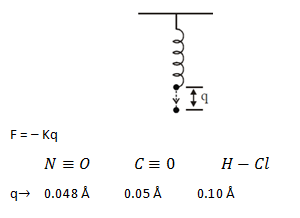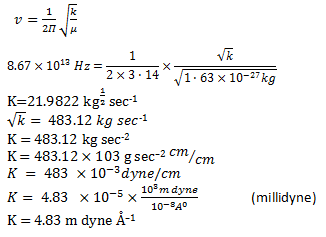This set of Organic Chemistry Multiple Choice Questions & Answers (MCQs) focuses on “Infrared Spectroscopy – 1”.
1. What is the relation between restoring force, f to the displacement q in Hooke’s law?
a) f = -kq
b) f = kq
c) f = kq2
d) f = -kq2
View Answer
Explanation: Restoring force f needed to extend or compress a spring by some distance is proportional to that distance.
needed to extend or compress a spring by some distance is proportional to that distance.
2. The intensity of an absorption band is always proportional to which of the following factor?
a) Atomic population
b) Molecular population of the initial state
c) Molecular population of the final state
d) Temperature
View Answer
Explanation: The probability of a transition taking place in initial state is the most important factor influencing the intensity of an observed l line. This probability is proportional to the population of the initial state involved in the transition.
3. On which factors the vibrational stretching frequency of diatomic molecule depend?
a) Force constant
b) Atomic population
c) Temperature
d) Magnetic field
View Answer
Explanation: The value of vibrating stretching frequency is shifted if the force constant of a bond changes with its electronic structure. Frequency shifts also take place on working with the same substance in different states (solids, liquids and gas). A substance usually absorbs at higher frequency in a gaseous state as compared to liquid and solid states.
4. In which unit Force constant is not expressed?
a) Dynes cm-1
b) dyne Å-1
c) Nm-1
d) kp
View Answer
Explanation: All of the above units are correct for force constant except kp, i.e. kilogram force or kilopond, which is the unit of force.
5. For HCI = 1.63 x 10-27 kg, the observed frequency = 2890 or v = 8.67 x 1013 Hz. What is the force constant K?
a) 4.83 m dyn Å-1
b) 8.43 dynes cm-1
c) 483 μm-1
d) 4.83 dyn Å-1
View Answer
6. Since the nuclei in a polyatomic molecule do not always vibrate in a simple harmonic manner, there arises which of the following situation?
a) Harmonicity
b) Anharmonicity in molecular vibrations
c) Fundamental frequencies
d) Infrared
View Answer
Explanation: q → displacement and K →Force constant

Since, H–Cl has single bond so having least force constant and respective q is longest among above three. q is larger when the force constant is smaller.
7. The vibrations, without a center of symmetry are active in which of the following region?
a) Infrared but inactive in Raman
b) Raman but inactive in IR
c) Raman and IR
d) Inactive in both Raman and IR
View Answer
Explanation: If a molecule has COS, then its vibrational mode will either IR active or Raman Active.
8. The frequency of vibration of a bond is a function of which factor?
a) Force constant of the bond
b) Masses of the atoms involved in bonding
c) Force constant of the bond and Masses of the atoms
d) Bond order
View Answer
9. What is the order of decreasing vibrational frequency for C — Cl, C — Br, C — C, C — O and C — H?
a) C-H, C-C, C-O, C- Cl, C-Br
b) C- Cl, C-Br, C-C, C -H, C-O
c) C-O, C-H, C-Br, C- Cl, C-C
d) C-Br, C- Cl, C-C, C-O, C-H
View Answer
Explanation: Since,
C – H > C – C > C – O > C – Cl > C – Br.
10. What is the correct increasing order of stretching frequencies for C ≡ C, C = C and C — C?
a) C — C > C = C > C ≡ C
b) C ≡ C > C = C > C — C
c) C — C > C = C < C ≡ C
d) C ≡ C < C — C > C = C
View Answer
Explanation: Since, v ∝ √k , k→ Force constant. Force constant trend is
Triple bond > Double bond > Single bond.
C ≡ C > C = C > C — C.
Sanfoundry Global Education & Learning Series – Organic Chemistry.
To practice all areas of Organic Chemistry, here is complete set of 1000+ Multiple Choice Questions and Answers.
If you find a mistake in question / option / answer, kindly take a screenshot and email to [email protected]
- Check Organic Chemistry Books
- Apply for Chemical Engineering Internship
- Check Chemical Engineering Books
- Practice Chemical Engineering MCQs


